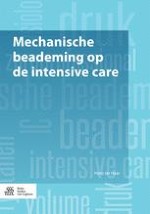Samenvatting
Het acute respiratory distress syndrome gaat gepaard met een ernstig verstoorde gaswisseling en een hoge mortaliteit. Oxygenatieproblemen door shunting zijn het meest opvallend, hoewel de klaring van kooldioxide ook problematisch kan zijn door alveolaire dode ruimte ventilatie en het gebruik van kleine teugvolumes. Beademing bij ARDS moet, net als elke andere beademing, voldoen aan de hoofddoelen van mechanische beademing, adequate gaswisseling, veiligheid, comfort en een zo kort mogelijke beademingsduur. Beademing alleen gericht op het verbeteren van de gaswisseling kan de prognose verslechteren, terwijl beademing gericht op het beperken van longschade de prognose verbetert. Longbeschermend beademen spaart niet alleen longen maar ook andere orgaansystemen en vormt de basis van een state of the art ARDS-behandeling. Vaak is echter meer noodzakelijk om de balans in het voordeel van de patiënt uit te laten slaan; zo kunnen aanvullende strategieën en technieken worden toegepast die de prognose verder verbeteren, zoals buikligging en het toepassen van spierverslapping.
